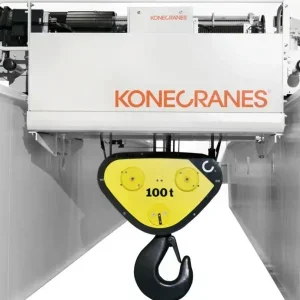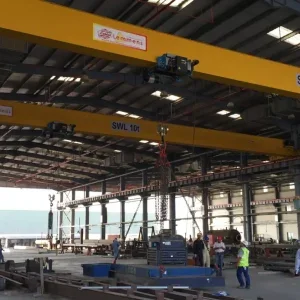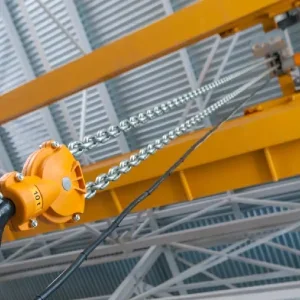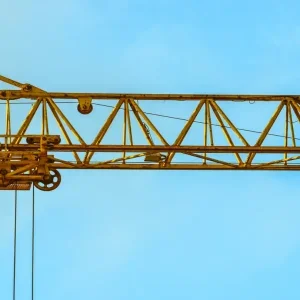JD Neuhaus Hebezeuge GmbH specialises in air-powered hoists, offering a range of units with lifting capacities from 250kg to 10t.
Originally designed for underground use, they are now used in a much wider range of applications, and are particularly suitable for hazardous areas, where explosion risks mean that electric hoists cannot be used. They can also tolerate high levels of dust and humidity, as well as wide variations in temperature.
In recent years, the number of industrial sectors where air – or pneumatic – hoists are used has risen dramatically and customers increasingly seek individual solutions to specific problems. JDN has therefore widened its product range to include complete crane installations, as well as electric hoists, enabling it to offer complete material handling packages.
Founded as long ago as 1745 as a smithy, JDN is now in its seventh generation of ownership by the same family, with Wilfried Neuhaus-Galladé as managing director today.
The headquarters are in Witten-Heven, Germany and there are subsidiaries in the UK, France, the USA and Singapore. The company employs more than 100 people and annual sales exceed DM 30m ($17m).
The foundations for today’s company were laid in 1952, when J. Diedrich Neuhaus was in charge. He substituted an air motor for the traditional chain blocks and thus gave JDN a technical advantage in safety-critical applications, particularly coal mining.
The mining industry remained the company’s main market for many years, taking almost 100% of output until the late 1960s. During the 1970s, as the mining sector declined, the company sought new markets in the shipbuilding, chemical, food and paper industries. As these areas of application developed, the air hoist began to lose its ‘mining’ image, was re-named the ‘Profi’ series and developed into a complete industrial programme, with ever increasing load capacities.
Further new markets were found, including the automotive, aerospace and offshore industries, and the company changed from being a producer of high-volume standard units, into a specialist in tailored solutions to solve customers’ individual material handling problems.
At the same time, it was realised that the continuing decline of the German mining industry would mean that the company could not continue to grow on the basis of domestic sales alone. Subsidiary companies were therefore set up in the USA in 1988, France in 1991 and Singapore in 1997.
In 1979, JDN produced the world’s first 100t capacity air hoist, followed in 1982 by 100t monorail hoists, specifically targeted at the offshore and cement industries. The range was widened further in 1992 with the introduction of complete crane installations.
Last year, the company introduced its ‘Mini’ range of economy hoists, still part of the Profi series but intended for light duty applications. The culmination of a four-year research and development programme, the new units range in weight from 9.5kg to 23kg, with lifting capacities from 250kg to 1,000kg. Lifts of up to 8m can be achieved with a single chain fall and direct lever control gives an infinitely variable range of speeds and precise positioning.
The newly developed load hook fitted to the Mini units is designed to allow broader and thicker harnesses, such as nylon straps, to be used. A galvanised, low-wear chain is also fitted and service life is further increased by the use of a precision chain guide.
The 125kg and 250kg versions are fitted with a 400W motor allowing maximum lifting speeds of 16m/min and 8m/min respectively, while the 500kg and 1000kg units feature a 1kW motor, giving lifting speeds of 10m/min and 5m/min. All the models in the range are fitted with a chain box to avoid the unloaded chain hanging down into the working area.
While the earlier models of the Profi series are designed for heavy duty industrial applications, the new Mini units are intended to meet the need for a versatile and easy to handle general purpose air hoist for workshop use. According to JDN, potential areas of application are almost unlimited, ranging from the chemical industry to car workshops, shipbuilding and the foundry industry. It is also suitable for use in hazardous environments, because being air-driven means that it does not produce any sparks.
JDN air-driven crane installations are offered in five basic types, all of which can be individually adapted to suit site conditions:
• suspension cranes, including minimised headroom versions with very flat trolleys
• gantry cranes with single or double main girders • cranes with mechanically couple synchronised monorail hoists
• cranes with parallel monorail hoists and single-axle adjustment
• slewing cranes.
Apart from these relatively standard packages, the company also installs more complex material handling systems using multiple cranes. A recent application across multiple work areas called for the use of a suspension crane in one area, which is fitted with an extending beam that passes the load to an adjacent workshop. It is in a hazardous area, so the installation had to be spark-proof, and safety interlocks were fitted to ensure that incorrect load movements would automatically stop the cranes.
Another customer ordered a set-up for handling filters, comprising a crane with a traversing trolley and a fixed branch line. The main requirement was that the crane trolley had to travel from the fixed branch onto the crane bridge, which then moved it around various points of the workshop. A semi-automatic positioning device was developed so that the operator could position the bridge in exactly the right place for the trolley to pass onto it from the fixed branch.
For moving large, fragile loads, JDN manufactured a double frame bridge crane with a 32t capacity, equipped with slow speed on the monorail hoist and high speed on the motion axles, with interlocks to ensure that accidental overspeeding is avoided.
Another recent major project was the supply of two air-driven monorail hoists with a total lifting capacity of 250 US tons for a drilling platform. These are the largest air-driven hoists ever supplied, the company says.
While none of these applications represents ground-breaking technology when compared to what can be achieved with other types of material handling systems, such as traditional electric hoists, these examples demonstrate an increasing need for complex one-off solutions using pneumatic technology in hostile environments.
Using pneumatics in this way is relatively new, at least in the crane industry, so it may offer JDN an opportunity to reinforce its already strong position in the air-powered hoist market.






